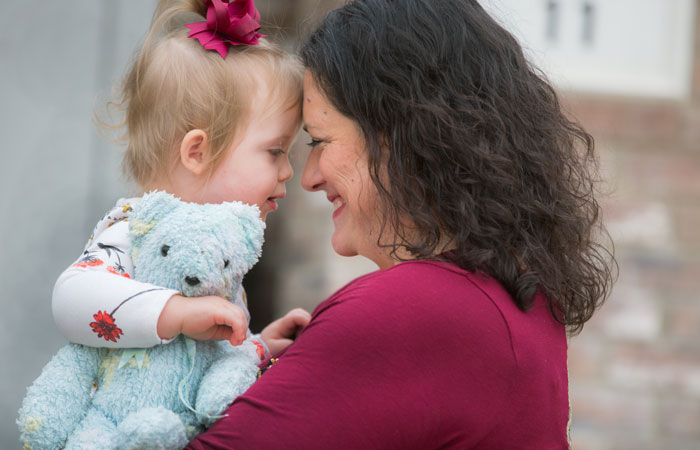‘This just shouldn’t be happening’
By Jan Jarvis

It was 4 a.m. when a very pregnant Nicole Purnell woke up in excruciating pain, weeks before her due date.
When she arrived at the hospital, physicians couldn’t find her child’s heartbeat.
“The next thing I remember was my OB slapping me on my legs and telling me to just keep breathing,” she said.
Purnell lost consciousness, but not before learning that her precious baby Cooper was stillborn. She, too, came dangerously close to becoming another tragic statistic.
| The problem The maternal mortality rate in Texas was 35.8 deaths per 100,000 births in 2014, compared to Italy’s 2.1 per 100,000 and France’s 5.5.The causes Cardiac events following overdoses, hypertension, hemorrhage, sepsis and suicide, among others. The solution Prevention, access to health care, identifying high-risk cases and preparing for them before an emergency occurs. |
Texas has the highest number of women dying due to complications of pregnancy in the country. In 2012, there were 121 maternal deaths, which include women who died up to a year after giving birth.
Although the United States spends more money on health care than other nations, the maternal mortality rate of more than 30 deaths per 100,000 births in 2014 is higher than other countries, according to Obstetrics and Gynecology. It contrasts dramatically to Italy’s 2.1 deaths per 100,000 live births, Japan’s 3.3 and France’s 5.5.
In Texas, the rates are among the highest in the world when compared to developed countries at 35.8 deaths per 100,000 births in 2014. It’s driving a statewide effort to find out why so many women are dying during delivery or afterwards.
For Amy Raines Milenkov, DrPH., Assistant Professor of Obstetrics and Gynecology at UNT Health Science Center, the dramatic rise in deaths has made the urgency to find answers all the more intense.
“You have a woman who is in a terrifying situation during what is supposed to be one of the happiest times in her life,” she said. “Just imagine the heartache for the family. This just shouldn’t be happening.”
The most common causes: cardiac events followed by drug overdoses. Other causes include hypertension, hemorrhage, homicide, sepsis and suicide, said Dr. Raines-Milenkov, who serves on the Texas Department of State Health Services Maternal Mortality and Morbidity Task Force.
Hypertension/preeclampsia nearly took Purnell’s life. She also suffered from hemorrhaging, which led to a five-day stay in the hospital’s intensive care unit and the transfer of 14 units of blood.
Such stories deeply trouble Dr. Raines-Milenkov, largely because most are preventable.
“We really can reduce the number of women who die with changes in practices, awareness and better coordination of services,” she said. “I don’t want any family to have to face the pain and life-long suffering from losing a mother, a wife, a daughter or sister to something that is preventable.”
Why women are dying
These days, death during childbirth seems like a tragedy from a different era. And even when families experience a close call with death, they often don’t talk openly about it.
“It’s something that stays in the family, unless of course the final event is death,” said Styliani “Stella” Goulopoulou, PhD, Assistant Professor, Institute for Cardiovascular and Metabolic Diseases. “People just don’t think about the possibility of a woman losing her life during what is considered a natural event.”
High blood pressure and preeclampsia – which account for nearly 18 percent of maternal deaths in the United States – are recognized as risk factors in virtually every book about pregnancy. Yet much is still not known about this life-threatening condition for mothers and babies.
“We don’t know the cause, we don’t know how it happens and we don’t know how to prevent it,” said Dr. Goulopoulou, whose research focuses on preeclampsia.
For some women, the placenta does not develop properly and the extra blood supply that should be traveling from mother to child does not get through. This leads to hypertension, swelling, kidney problems, and it can also affect the growth of the baby.
The cure has long been considered delivery, because the problems usually go away after birth. But that theory is shifting, Dr. Goulopoulou said. In many cases, the woman goes home and then later her blood pressure rises so high that she dies before she can get to the hospital.
“Delivery is really the start of the cure,” said Purnell. “Blood pressure spikes five to 10 days after delivery, which is when a lot of moms die.”
Who is at risk?
Black women bear the greatest risk of dying during childbirth.
They are three to four times as likely as white women to die during childbirth or one year postpartum. In 2011-12, only 11.4 percent of births in Texas were to back women, and yet they accounted for 28.8 percent of all maternal deaths, according to a report by the Maternal Mortality and Morbidity Task Force.
Poverty and geographic disparities add to the risk. Lack of access to health care also plays a big part, as does obesity, hypertension and diabetes.
The largest risk factor for fetal and infant deaths in Tarrant County is a mother’s unhealthy weight, Dr. Raines-Milenkov said. All of these conditions can be managed before pregnancy to reduce the risks
“Women have to have access to healthcare throughout their life,” she said.
Prevention and opportunities
Preventing maternal deaths starts before a woman ever gets pregnant and should continue long after childbirth.
But accessing health care is often challenging in Texas, where over half of births are paid for by Medicaid, totaling more than $2.2 billion per year. Cuts made to women’s health and planning services have made it all the more difficult.
“Women have been caught in the terrifying situation where they lose coverage and access very soon after their baby is born,” Dr. Raines-Milenkov said.
Relief recently came in the form of the expansion of Healthy Texas Women, a state program offering low-cost or free health care. The Medicaid program has been extended a year, which allows women to get treatment for hypertension, diabetes and other chronic conditions following pregnancy.
Routine care after birth opens the door to screening and referring women with depression and other mental health issues, substance abuse needs and intimate partner violence, Dr. Raines-Milenkov said.
Steps to improve outcomes before the woman leaves the hospital also prove to be successful.
Safety Bundles, a term coined by the Institute of Healthcare Improvement, provide specific steps and draw from evidence-based quality improvement processes. They are a way to identify women who are at risk and be ready for them in case of an emergency by having medications, equipment and medical staff ready when the woman comes in the door.
To prepare for emergencies such as excessive bleeding, rapid response teams practice on mannequins so they are able to handle emergencies during childbirth. Heightened awareness of the risks of maternal mortality and the symptoms associated with preeclampsia also make a difference.
After the crushing heartbreak of losing her son, Purnell dedicated her time to bringing attention to the risks of preeclampsia. Today she stays busy as a volunteer with the Preeclampsia Foundation and chair of its annual Promise Walk.
Nearly a decade after Cooper’s death, Purnell gave birth to a healthy baby girl named Lorraine. The child was born on Purnell’s 33rd birthday.
“After my experience I stumbled on to the Preeclampsia Foundation and realized finally I was not alone,” she said. “There were other women out there who have been through this same thing.”



![Uyen Sa Nguyen Scaled[58]](https://www.unthsc.edu/newsroom/wp-content/uploads/sites/16/Uyen-Sa-Nguyen-scaled58-145x175.jpg)

Social media